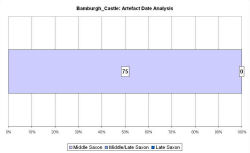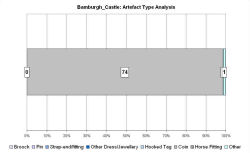Fingerprint charts for i) artefact date analysis, ii) artefact type analysis, iii) artefact metal analysis and iv) coins – date of production




Archives:
http://ads.ahds.ac.uk/catalogue/search/fr.cfm?rcn=NMR_NATINV-7536
http://ads.ahds.ac.uk/catalogue/search/fr.cfm?rcn=EHNMR-1238812
http://ads.ahds.ac.uk/catalogue/search/fr.cfm?rcn=EHNMR-1141191
Bamburgh Castle lies 32km south of Berwick-upon-Tweed. The 12th-century royal castle is situated on top of a volcanic basalt outcrop on the edge of the North Sea, where it overlooks a long stretch of beach and sand dunes. There are commanding views over the Farne Islands and Holy Island, and inland there are views over the Cheviot Hills. The castle also lies within a prosperous agricultural area with well-drained soils; surviving medieval records suggest the lands of north Northumberland and Lower Tweeddale produced greater estate revenues than estates in the south of the county. By AD 547 the site was a royal centre, Din Guyardi, the capital of the royal dynasty of Northumbria. Bamburgh was accorded the dual status of urbs and civitas by Bede, indicating its importance.
The castle site was first excavated from 1960-2 by Dr Brian Hope-Taylor. Further excavations from 1969-74 recovered Anglo-Saxon coins, although the dig was poorly documented and was never fully published. The Bamburgh Project began excavations in 1997. Resistivity and radar survey of the lawned area within the Inner Ward revealed the traces of earlier buildings, possibly Anglo-Saxon in date, including the probable crypt of the earliest Saxon church on the site. In 1817 a cist burial ground was discovered by the dunes to the south of the castle. The Bamburgh Research Project successfully re-located this burial ground in 1998. The bodies are perhaps those of the aristocratic Anglo-Saxon court at Bamburgh.
The VASLE dataset is derived from records on the PAS and EMC databases. The relationship with the castle and excavated sites is not known.
Fingerprint charts for i) artefact date analysis, ii) artefact type analysis, iii) artefact metal analysis and iv) coins – date of production




© Internet Archaeology/Author(s)
URL: http://intarch.ac.uk/journal/issue25/2/4.4.1.html
Last updated: Tues Apr 21 2009